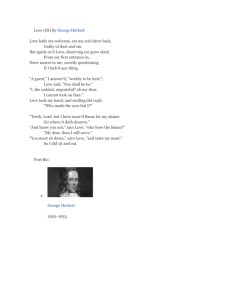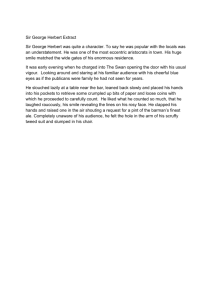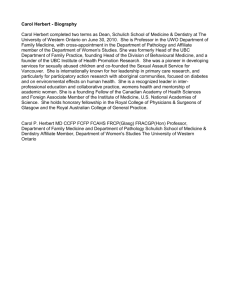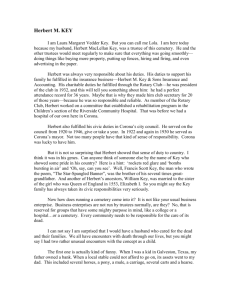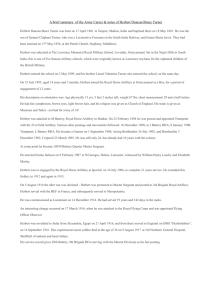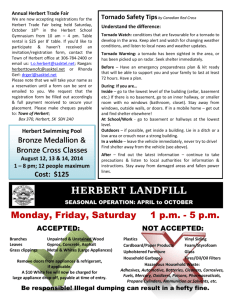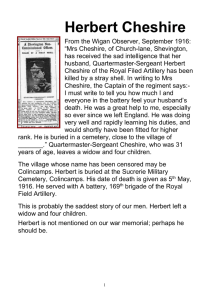Herbert Fieldmouse, Secret Agent
advertisement
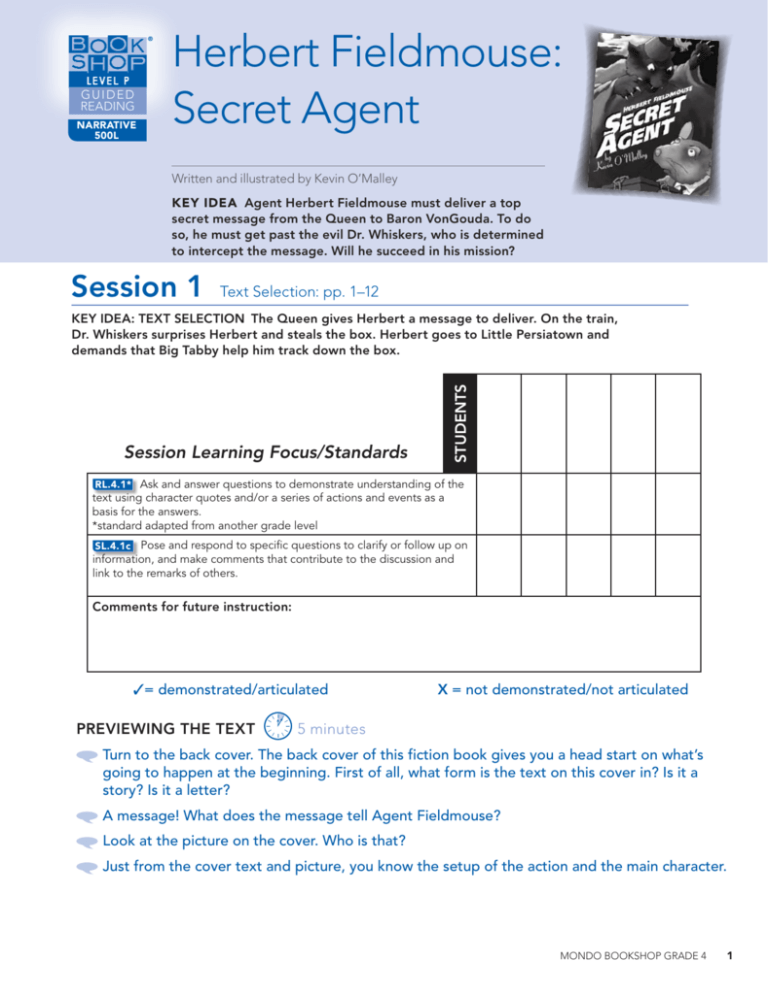
® Guided Reading Narrative 500L Herbert Fieldmouse: Secret Agent Written and illustrated by Kevin O’Malley Key IDEA Agent Herbert Fieldmouse must deliver a top secret message from the Queen to Baron VonGouda. To do so, he must get past the evil Dr. Whiskers, who is determined to intercept the message. Will he succeed in his mission? Session 1 Text Selection: pp. 1–12 Session Learning Focus/Standards Students key idea: text selection The Queen gives Herbert a message to deliver. On the train, Dr. Whiskers surprises Herbert and steals the box. Herbert goes to Little Persiatown and demands that Big Tabby help him track down the box. RL.4.1* Ask and answer questions to demonstrate understanding of the text using character quotes and/or a series of actions and events as a basis for the answers. *standard adapted from another grade level SL.4.1c Pose and respond to specific questions to clarify or follow up on information, and make comments that contribute to the discussion and link to the remarks of others. Comments for future instruction: ✓= demonstrated/articulated PREVIEWING THE TEXT X = not demonstrated/not articulated 5 minutes urn to the back cover. The back cover of this fiction book gives you a head start on what’s T going to happen at the beginning. First of all, what form is the text on this cover in? Is it a story? Is it a letter? A message! What does the message tell Agent Fieldmouse? Look at the picture on the cover. Who is that? Just from the cover text and picture, you know the setup of the action and the main character. Mondo Bookshop Grade 4 1 READING THE TEXT CLOSELY 10 minutes After reading and viewing these pages, what questions do you have? What answers do you find? Another question, anyone? Answer? How do you know it’s a box? s we read, we’re going to use our question-and-answer method to learn about characters A and plot. Ask questions about the illustrations as well as the text. When you’re answering, quote from what the characters say. If there isn’t a quote, refer to an action or illustration. Do this as you read to page 12. ur goal as readers is to enjoy the adventure of Herbert Fieldmouse, and to understand what a O narrative is. To do that, we’re going to use our reading focus. DISCUSSING THE TEXT 10 minutes s we talk together today, first we’ll work in pairs. Now I’d like someone to tell us all a question A they’d like to discuss with a partner. What answer can you give us? hen you ask a question about an action or character, you can’t always find the answer right W away. You may have to wait to see what happens. et’s do a close read of page 11. When I came to this phrase, catnip operation” I had to stop L and think. What’s catnip? Who here can tell us? And operation—is Herbert talking about the kind of operation you have at the hospital? What nearby words told you that? So what does “catnip operation” mean? ou did a great job using the focus of asking and answering questions. As you read, keep Y doing that, and refer to quotes and actions from the story. 2 Herbert Fieldmouse: Secret Agent ® Guided Reading Narrative 500L Herbert Fieldmouse: Secret Agent Written and illustrated by Kevin O’Malley Key IDEA Agent Herbert Fieldmouse must deliver a top secret message from the Queen to Baron VonGouda. To do so, he must get past the evil Dr. Whiskers, who is determined to intercept the message. Will he succeed in his mission? Students Session 2 Text Selection: pp. 1–12 Session Learning Focus/Standards RL.4.1* Ask and answer questions to demonstrate understanding of the text using character quotes and/or a series of actions and events as a basis for the answers. *standard adapted from another grade level RL.4.5* Identify how the author describes characters, sets up major events across the story and uses events to establish the overall plot. *standard adapted from another grade level SL.4.1c Pose and respond to specific questions to clarify or follow up on information, and make comments that contribute to the discussion and link to the remarks of others. Comments for future instruction: X = not demonstrated/not articulated ✓= demonstrated/articulated RETURNING TO THE TEXT 5 minutes Let’s review. What reading focus did we mainly use last time? I’ve got a question for you to answer: what has Herbert done so far? READING THE TEXT CLOSELY 10 minutes oday, we’re going to focus on seeing how the author sets up the plot and describes the T characters. Reread pages 11 through 12 silently. There’s a new character on these pages—Big Tabby. My question is: who is Big Tabby? I’d like to hear an answer based on the text. Mondo Bookshop Grade 4 1 Is he a good guy or a bad guy, and how do you know? Now, let’s look at how these pages set up the plot. Why is this visit to Big Tabby in the plot? he visit to Big Tabby is the next step in the plot. Herbert is getting deeper into the action T and the mystery. How do the illustrations work with the plot? DISCUSSING THE TEXT 10 minutes I like the way we’ve been building on each other’s ideas as we discuss Herbert Fieldmouse. Remember that today’s reading focuses are on how the author describes characters and sets up plot events, and making connections between the text and illustrations. Turn to pages 5 through 6. To start our discussion of how the author describes Herbert, I’d like someone to ask a question based on what Herbert tells us on page 5. Can you find a quote in the text that helps us answer your question? I know that all of you always study for your tests and always tell the truth, so you might have to try hard to put yourself in Herbert’s place—but how would you feel in the situation he describes? ow, look at the picture. Does it make you feel a little like the way Herbert says he N feels? How? he text and picture work together to describe his character. As you discuss this first half T of the book, I’d like you to pause after each new action. A scene in this book might be a page, or two or three pages. In your groups, ask and answer questions about the text and the pictures in that scene. Discuss how that scene is a new step in the plot and how the illustrations add to your understanding of the scene. he last two words in this section are set apart in big red script: “Quivering Whisker.” The T word quivering is pretty difficult. Let’s try to figure it out any way we can. In this story, what is the Quivering Whisker? I don’t think that gives me any clues to the meaning of quivering. Next, let’s look for context clues. Are there any words nearby that might help us guess the meaning of quivering? How might that help? Okay, quivering is something a whisker might do or look like. That’s a start, but a whisker can do or look like many things. It might fall out. It might hit something. It might be gray. We’ve gotten a little closer, but not close enough to define quivering. We’ve got to take another step. What step can you always take to find the meaning of a word? ha! I look in the dictionary and I see that quiver means “to shake or tremble slightly.” A Quivering adds the -ing ending. So what does quivering mean? Note this word tells us something about a character. Why would a cat’s whiskers quiver? If Pasha’s boat is called the Quivering Whisker, what does that hint about Pasha, even before you’ve met her? e’re discussing in various kinds of groups today. Different people like different-sized W groups. Think about which kind you like best, and try to find at least one reason why each kind of group is good. 2 Herbert Fieldmouse: Secret Agent ® Guided Reading Narrative 500L Herbert Fieldmouse: Secret Agent Written and illustrated by Kevin O’Malley Key IDEA Agent Herbert Fieldmouse must deliver a top secret message from the Queen to Baron VonGouda. To do so, he must get past the evil Dr. Whiskers, who is determined to intercept the message. Will he succeed in his mission? Session 3 Text Selection: pp. 13–32 Students key idea: text selection The plot thickens as Pasha takes Herbert to the evil island of Dr. Whiskers. Herbert penetrates the fortress, gets through Dr. Whiskers’ obstacles, and is saved by Pasha in her boat. At the end, the secret message is revealed. Session Learning Focus/Standards RL.4.1* Ask and answer questions to demonstrate understanding of the text using character quotes and/or a series of actions and events as a basis for the answers. *standard adapted from another grade level RL.4.5* Identify how the author describes characters, sets up major events across the story and uses events to establish the overall plot. *standard adapted from another grade level RL.4.7 Make connections between the text of a story or drama and a visual or oral presentation of the text, identifying where each version reflects specific descriptions and directions in the text. SL.4.1c Pose and respond to specific questions to clarify or follow up on information, and make comments that contribute to the discussion and link to the remarks of others. Comments for future instruction: ✓= demonstrated/articulated RETURNING TO THE TEXT X = not demonstrated/not articulated 5 minutes Where did we leave off last time? What strategies did you use to follow the action? Now, we’re going to continue reading the second section and see how the story ends! Mondo Bookshop Grade 4 1 READING THE TEXT CLOSELY 10 minutes ead pages 13 to 15 silently. Let’s look at page 13. It only has one line of text: “The place R wasn’t hard to find.” Which tells you more about the place—the text or the picture? What details and information does the picture give that the text doesn’t? ithout this illustration, you wouldn’t have much of an idea of where the scene was taking W place. The author could have written a page of words describing it. How is seeing it in an illustration different? s you read, look carefully at every picture. Make connections like we did together to expand A your understanding of this story. DISCUSSING THE TEXT 10 minutes oday, we’re asking and answering questions, identifying character descriptions and events, T and making connections between illustrations and text. Did you notice that the story in this section has more scenes and action than in the first section? Let’s look closely at the pictures. How do they show that the action is heating up? ow the characters are animals. The pictures show lots of expressions on their faces. How N would they seem different if you just read words about them? In your groups, bring up lots of questions about how the illustrations show the plot and describe the characters. Give everyone in the group a chance to ask and answer, and try to build on each others’ ideas. 2 Herbert Fieldmouse: Secret Agent
